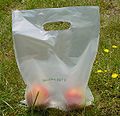Commonly used types of bioplastics are based on cellulose, starch, glucose and oil. Specific techniques are then employed to convert these feedstocks into thermoplastic starch, polylactic acid, poly-3-hydroxybutyrate, polyamide 11 and biopolyethylene.
Starch
Today, thermoplastic starch, accounting for about 50 % (some sources state about 80 %) of the global bioplastics market, is the most significant and widely used bioplastic. Flexibiliser and plasticiser such as sorbitol and glycerine are added to process the starch. Thermoplastic starch generally represents just one component of which starch based bioplastics are formed. The second part of the blends consists of water repellent and biologically degradable polymers like polyester, polyesteramids, polyesterurethanes or polyvinylalcohols. Throughout the melting process, the water soluble, disperse starch phase and the water-insoluble, plastic are bond together to form a waterproof starch plastic. Applications of thermoplastic starch are bags, yogurt tubs, cups, plant pots, cutlery, diaper foil, coated paper and cardboard. Most of the starch derives from crops such as potatoes or corn.
PLA
PLA (polylactic acid or polylactide) is by far the most promising bioplastic for the near future. Its characteristics resemble conventional fossil fuel based plastics such as polyethylene (PE), polypropylene (PP) and polyethylene terephthalate (PET). It can easily be processed on manufacturing facilities that already exists for the production of common petrochemical based plastics – no further industrial investments are required. PLA is mostly produced by the fermentation of starch from crops, commonly corn, wheat or sugarcane into lactic acid followed by subsequent polymerization.
Its blends have a wide range of applications including computer and mobile phone casings, biodegradable medical implants, foil, moulds, tins, cups, bottles and packaging devices.
PLA and PLA copolymer plastics have already been uses successfully for medical and pharmaceutical purposes such as the production of screws, nails, plates and implants that can be resorbed by the body. Also the use of PLA – nanoparticles as drug carrier or MRI contrast agent is currently investigated.
PLA is a very versatile bioplastic. By varying composition and quality it can be designed to biodegrade quickly or last for years. Additionally, PLA possesses an extraordinary stability, as well as an extremely high transparency.
However, PLA also has a significant disadvantage. The plastic softens at a temperature of about 60 degrees Celsius, which limits its application for the production of packages for hot drinks and food. Copolymerisation with heat resistant polymers and the addition of fillers overcome these drawbacks.
A barrier for wider application is still the high cost of production. While the feedstock for conventional thermoplastics like PE costs about 1000 € / ton the expense for lactic acid for the production of PLA is about 1300 € / ton – significantly higher. But as the price for crude oil is constantly rising and improved PLA manufacturing methods are developed, the difference in prices becomes continuously smaller.
PHB
The bio-polyester: poly-3-hydroxybutyrate is generally produced by bacteria processing glucose or starch. Its characteristics are similar to those of the fossil crude oil derived plastic polypropylene.
The production of PHB is currently expanding. Companies worldwide, especially the South American sugar industry, either begin production of PHB or enlarge their existing production capacity, which would most likely result in a price reduction to fewer than 5 € / kg (this would still be about 4 times the market price of polyethylene). PHB is distinguished from most other currently available biodegradable plastics primarily by its physical characteristics such as the insolubility in water and its resistance to hydrolytic degradation. It produces transparent film at a melting point of 175° C, and is biodegradable without residue. PHB is probably the most common type of a substance class termed as polyhydroxyalkanoates, but also many other polymers of this polyester class are produced by a variety of organisms.
The application of PHB blends varies from the fabrication of glues to hard rubber.
PA 11
A biopolymer derived from natural oil is polyamide 11 (PA 11). This polyamide bioplastic is also known under the trade name Rilsan. Although, PA 11 derives from renewable resources (castor beans) it is not biodegradable.
It is used in high-performance applications such as automotive fuel lines, pneumatic airbrake tubing, electrical anti-termite cable sheathing, oil and gas flexible pipes and control fluid umbilicals, sports shoes, electronic device components and catheters.
PE
Polyethylene (PE) is generally known as a fossil based polymer. However, it can simply be converted form bioethanol (by dehydration) which is produced in large scale by fermentation of agricultural feedstocks such as sugar cane or corn. Bio-polyethylene is chemically and physically identical to traditional polyethylene – it does not biodegrade but can be recycled.
This article is also available as podcast:
coming soon…

It was a awe-inspiring post and it has a significant meaning and thanks for sharing the information.Would love to read your next post too……
Thanks
Regards
PET preforms manufacturers in india
This article is very interesting. The conflict between using polymers based on fossil fuels or based on food crops will continue until we are able to extract starch from cellulosic material.
Dear Anant
Thanks for your comment.
I agree, this conflict will probably decline after industrializing non food crops for polymer or fuel production. Actually, this process has already begun.
But especially in Europe, many farmers receive incentive payments for non-growing crop. So the real reason of rising food prices mainly relies on speculation. There is an InnovativeIndustry.net article about the Food vs. Fuel Controversy which might interest you.